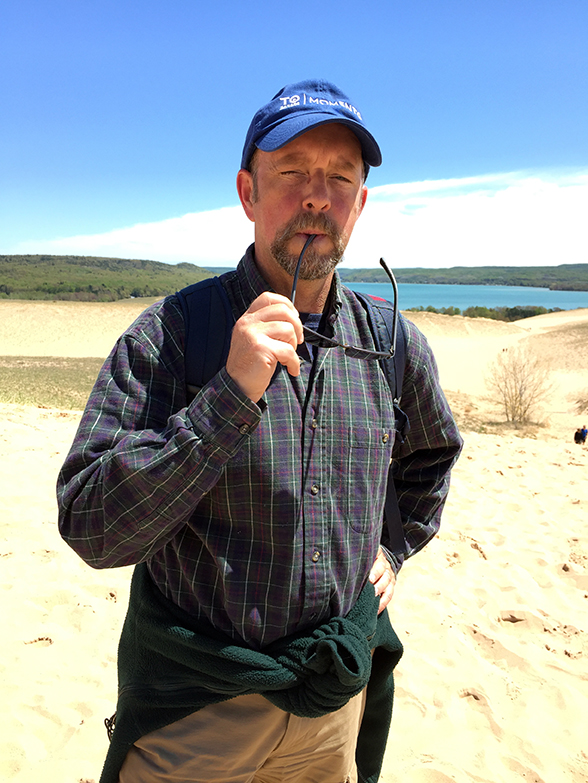Wayne Reeves retires as Chief Curator
by Andrew Stewart
Wayne joined what was then called City of Toronto Museums in 2009, providing leadership for the Collections and Conservation unit, responsible for managing Toronto’s 1.3-million-item artifact collection. He had previously led policy and research projects for Toronto Parks, Forestry Wayne Reeves, who retired on February 25, is seen here thinking hard at the Sleeping Bear Dunes National Lakeshore in Michigan on May 20, 2018. Photo courtesy Julia York
Wayne Reeves, who retired on February 25, is seen here thinking hard at the Sleeping Bear Dunes National Lakeshore in Michigan on May 20, 2018. Photo courtesy Julia York
and Recreation as a historical geographer. His specialty was the history of Toronto’s waterfront – contributing substantially to master plans for parks and development along Toronto’s ever-evolving shoreline.
He has written widely for scholarly and public readerships on topics relating to the history of Toronto. These include water infrastructure (including sewers and waste disposal – see “Burying and burning trash on Toronto’s Military Reserve” in the F&D, March 2015), brewing and, most recently, Packaged Toronto: a Collection of the City’s Historic Design, together with Spacing’s Matt Blackett and Alexandra Avdichuk, the City’s Supervisor of Collections and Conservation.
Wayne was hired just as planning for the City’s War of 1812 Bicentennial commemoration was getting underway. He directed the research and exhibit program for the bicentennial and was deeply involved in the design of exhibits unveiled in the Fort York Visitor Centre in September 2016. The building and the exhibits were never meant to dominate the National Historic Site but rather, as Brian Leigh Dunnigan writes in his review (F&D, December 2016), serve to introduce the site and the conflict at the heart of the story of the fort.
Together with David O’Hara, manager of Fort York, and his staff, and a great many other people, Wayne and his staff rose to the challenge of designing, costing and ultimately opening the Visitor Centre, one of Toronto’s great attractions, and internationally recognized for its architecture as well as its exhibits. Wayne wrote about his vision for the Vault (in the F&D, October 2010), a special room inside the Visitor Centre built to highlight prized artifacts with unique stories in the City’s collections. He then oversaw a joint effort by the Canadian Conservation Institute and the City to restore and exhibit the colours of the 3rd York Militia in the Vault (F&D, June 2013).
Together with War of 1812 Bicentennial Historian Richard Gerrard, Wayne curated Finding the Fallen: The Battle of York Remembered, which opened in the Market Gallery in 2012 (and is still on display in Fort York’s Brick Magazine) and included a book of remembrance with names of all participants in the conflict. So many commemorative events, talks, concerts, walks and exhibits during that and the following year put the fort under a favourable spotlight, setting the stage for the opening of the Visitor Centre building.
The 1812 commemoration was followed closely by that of 1914 – the commemoration of the Great War, which occupied Fort York with another intricate set of exhibits, events and programs involving public participation. These were, again, curated by Wayne and special projects coordinator Sandra Shaul. The Great War – in your Attic, Closet or Storage Locker was just one of many. The First World War touched many families in Toronto, as well as many who came here after the war, and this commemoration was deeply felt.
Wayne’s collegial nature served the interests of the fort and the community at large. He and Jane French from his staff worked closely with the Mississauga of the (then New) Credit First Nation on the exhibit Outcome of the War of 1812: First Nations Betrayed, which opened in their new community centre near Hagersville. He worked with the late Steve Otto and Michael Peters of The Friends, and the late Chris Baker, exhibition coordinator for Toronto Culture, to mount At Ease: The Military at Play in Nineteenth-Century Canada in the Blue Barracks. He generously gave his time and expertise, contributing articles and book reviews to The Fife and Drum.
He has also worked closely with fort staff and volunteers at The Friends and the Fort York Foundation in acquiring and exhibiting historic items of special affinity to the history of the fort and Toronto. These include the Cawthra family heirlooms, Upper Canada Preserved medals and Chewett’s War of 1812 regimental order book. He worked collaboratively with fort staff on two layers of interpretive panels – one inside the fort walls, the other installed as wayfinding posts across the National Historic Site, bringing an unprecedented depth and visibility to the historic interpretation of the site for visitors. These panels, beautifully designed and fabricated, have held up well over the course of a decade now.
Wayne, still a young man, and with a depth of experience, has much more to contribute. He and his wife Julia are accredited judges of craft beer and have planted heirloom varieties of apples from which they make cider. We wish him well in his future
endeavours. Exploring and writing about the history of our city we’re sure are among them.
Dr. Andrew Stewart is an award-winning archaeologist, an expert digital map-maker, and the Chair of the Fort York Foundation.